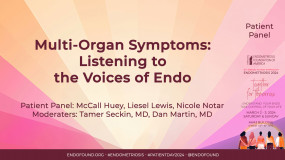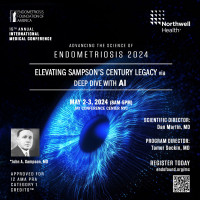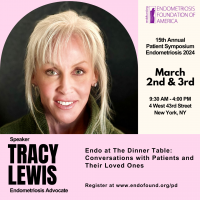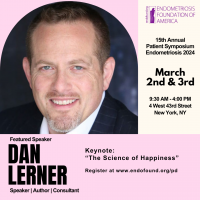Okay, endometrial essentials with excision. So we gave you a extreme case of endometriosis so you, I'm sure you all wake up, woke up right now. As you see, the disease is a multiple organ disease. The patients have multiple organ symptoms. It is the most complicated non-malignant disease. It is enigmatic we say, but truthfully, if you know the disease, there's not much enigma here. I mean if we are aware of it, as you'll see throughout this presentation, if you are with the right people, if your guide doctor and the caregivers are right people, you will be fine. The disease is very treatable. Let's not talk about cure. I'll come to that later.
(01:08)
Magnificent sky. Beautiful. I'm not an astrophysicist, but there's something magical. Can you turn the lights off a little bit? It's shining. Could you turn the lights off so we can feel the evening? So there is what we see, what we see is the stars. It is nothing but energy accumulating in matter. What we don't see is the dark elements there. We don't see the dead stars or black holes. There's magnetic presence in that sky. So I say this because when I look at the pelvis, I get more philosophical as I get senior, let's put it that way. A little philosophical and I do like this poetic elation. When I look inside, I really, I see the lesions, but I also realize there's more to see. I kind of appropriate this with, as you look at the sky, there's negative energy there truthfully. And the met is negative energy inside and I will, the bottom line is similar to what we see as moon.
(02:37)
We never see the dark side of the moon. We see the only the bright side of the moon as I didn't know that moon really does not change it face. We never see the dark side. We always see the bright side of the moon, whether it's crescent or full moon. So there is something about full moon that is magnificently interesting. It's not coincidence that female periods are approximately same thing as lunar cycles. That's not, that's not coincidence. There is something magnetic obviously with the moon and the tides. As you know, this ship got stuck in swish canal, world's biggest ship. The canal was closed. The whole Red Sea traffic, not by Yemeni Houthis or so this is, as you know, it's the moon that low tide, only full moon helped this ship to be freed. So the reason I'm mentioning this, lunar ization has grabbed the attention of Mrs. Foster from Austria.
(03:59)
They speculated that synchronization of human reproduction, lunars action lunar cycle may have been stronger in ancient times, but exposure to artificial light in modern life had dulled the moon's influence. The reason I say this, because when the full moon is out, there's hunting goes on, there's more security. When there is no moon, there is more intimacy. Everybody is at their homes. There is this making babies time. That is part of the evolutionary mammalian history. We can really think about it. So I'm going to move this because I kind of wanted try to, this is the 13,000 bc, probably the oldest ever woman giving birth breach birth from, this is from Ufa Turkey. This is the oldest religious practicing era. There's only one female figure in that other than animal figures and everything there and it, it's about this picture. I mean overall men died at wars, but women have died just because they were women. This is the menstrual huts in Nepal. This is still being practiced and there's always, every year there's death reported from there. We have menstrual data. In other words, the taboos are here too. We don't have menstrual hearts, but we have other issues. I don't know why this is going like this. This is not the presentation I want to, I'm sorry I'm in a different presentation here.
(05:55)
This is something I didn't want to present, believed or not. Let's see. Okay. Alright. That's why I'm sorry. Okay, let's start from here. This was something I didn't want to get in, but the bottom line is, so ending in Machu really starts at the beginning. So you see this is a New York Times cartoonist, Luba Kova. You heard from the speakers. The first one is a woman trapped and asking for help, but she's trapped inside the uterus. This is a gift from Luba Kova to our me personally. And the second one is a fertility clock where some women are happy. The lateness of the clock. Some women are strapped with infertility. These are beautiful and cartoons that makes you think the power of cartoons are incredible. So ending endometriosis starts at the beginning.
(07:06)
There's a value of early detection and proper management and the best prevention could be that. So this is a 17-year-old kid. We just operate on her and you could see these lesions up here. You can see my arrow. But the thing is the lesions are very different than the adult lesions. These are angiogenesis lesions. If you're not familiar, you cannot pay attention to these and leave them untreated at times or the right treatment. We are going to come. That's why I mentioned this topic as excision. These should not be burned out in my opinion. We're going to come to that. So we have to draw the line between management and treatment. Management is different. Treat is different. Birth control pills or everything else from diet to others that you know they are management. You cannot manage treat endometriosis with injections to pelvis to every nerve. You cannot treat endometriosis by giving vaginal Valium.
(08:19)
They give vaginal Valium, they give vaginal. I've seen people getting vaginal Viagra to increase blood circulation. I mean you haven't heard it. I've seen it, but I've seen also in New York City, 12-year-old kid on morphine patches. That's not treatment. So this is a great, great publications coming up from just recently. Finally, academic circles have really realized that that surgery is a viable option. In the past, no one speaks spoke in favor of surgery in the academic circle. Now this is coming up. There is serious dissatisfaction using hormonal drugs. So these, there's another article coming up. These articles favor surgery and expressing concern for situation that medical management should not be pushed when their symptoms are prominent. This was from some way go from China. Writes beautiful with Michael Michel Canas. Another one again came up just recently. These are very recent. This is January. It says the answers previous questionnaire who asked s wrote this, which we know already, but he wrote it.
(09:54)
The real choice may not be between medical treatment, surgery. The real choice is medical treatment alone and medical surgery plus postoperative medical treatment. So in other words, surgery itself is not enough. Medical treatment is an option. And they also talked about trust based on transparency and empathy is the crucial part of patient-centered care. It's good that this is coming into literature. Finally, this is exactly what we've been practicing in private medicine for years. Maybe making us different because we have time to spend with these patients. Healthcare providers should never take granted. That diagnosed or suspected end images is always the real sole origin of complaints. So you need multidisciplinary team and the role of empathy is a must. Same thing. The patients want to be heard, understood, validated and vindicated. So it's centered medicine, not surgeon centered practice. What causes endometriosis. A hundred years ago there was a genius guy called Samson named this endometriosis.
(11:19)
Even though disease were the cells were known before, but Samsons was special, he understood the role of menstruation and its association with periods. So where do these cells come from? How did this disease start? I'm going to try to look at this with you now. Well, Samsung was genius and I think like many other hypothetical explanations, Samsung's hypothesis now as a proven theory because with evidence we know that especially with this article just published two years ago, there's a convincing DNA evidence today. Let's not gaslight the whole thing. This is true endometriosis, the disease of menstruation. There's a convincing DNA evidence that superficial all type of endometrial, superficial peritoneal deep endo and endometrioma from the same patients share up the same genetic makeup that these lesion types originate from the similar and identical source. That's the intrauterine endometrial tissue.
(12:44)
So this is why there's thousands of scientists believe and they based their research and the messages do not come from the sky like the babies come by. Stor, seriously, I'm going to stop here because I could say more, but unfortunately the internet is not a source of when you talk a lot, that doesn't mean that you're right. There's science and you cannot deny science. So in a simple term it's the presence of menstrual tissue outside the uterine cavity. But these cells are not the same cells because they go through the evolution of being inside and they go to natural selection. The period comes out. What goes on inside those cells survives the body, the fight with the body and their survival. So in other words, they act differently. They're progesterone resistant, they secrete their own estrogen, genetically epigene, genetically, especially the stromal component. We say the cement portion of the endometriosis goes some changes and they get aggressive. Glandular portion also have goes mutations, but they don't really necessarily become cancer. This is the endometrium. So the underlying pathology is really like Samsung almost said that, but Samsung's time, there was no stem cells. But really the real problem is a defective programmed stem cells of the endometrium.
(14:33)
So whatever it is, it leaks backward here. And this is a picture of, I caught this picture and if you do surgery during the time of period, you will see blood coming from the tube like that. This is real. So there are three types of endometriosis. As you saw. You saw these three women, courageous women went over their cases, endometrioma deeply infiltrating endometriosis, all sort of organ attacking. Endometriosis are deep endometriosis, but this peritoneal endometriosis is the culprit. I think biggest troublemaker is peritoneal endometriosis because there's no blood test, there's no imaging techniques, it's the patient in pain, mourning and really ending up in emergency. Nobody's blaming them and they're telling it's in their head and families hands are tied unless the patient is believed. And there's a doctor who really asks the right question. The right question is if you know the disease, you know how to ask the right question.
(15:38)
So peritoneal endometriosis is the reason why endometriosis is 10 years delayed even more. And also the treatment of peritoneal endometriosis is also debatable because I am going to be talking about the excision surgery, which is why some people are never treated well with these symptoms may be persistent because of improper approach. So peritoneum is a beautiful organ that covers all the internal cavity like we have skin covering our body. Peritoneum covers the intestine. Intestine, its attachment to the body inside, which we call mesentary and parly. It covers the whole from diaphragm all the way to the rectum. Mainly it covers in pelvis around the reproductive organs, but much of the peritoneum and pelvis has nothing to do with the ovary and uterus, but the surrounding tissue of the bowel bladder and the nerves behind the peritoneum, ureter and everything else. So this is normal peritoneum, shiny, transparent, not too much blood vessels beautiful.
(16:54)
This is rectum. This is uterus and bilateral and as I said, it's shiny, transparent, beautiful organ slippery so the bowels can move around. We are going to come to adhesions and scar tissue later. But what happens with constant exposure to blood leaves makes these holes, creates inflammatory markings in this peritoneum. Most likely this is a retrograde bleeding. This blood really gets trapped in this holes and probably serves a little pothole like the rain is pulled inside these lesions in the peritoneum be the source of these other lesions that you see around. Not everybody's bleeding is same, some people bleed a lot. This is something that we do not know the answer yet. So when you do remove these clots or blood, you see the gland there. This is one of everything you see is my pictures in this presentation I didn't get from anywhere else. So you can see the glands. It's truly these glands come, but all this blood contains so much inflammatory cells, stem cells, white blood cells, natural killer cells, the whole universe, the stars that use like milky ways here.
(18:27)
So when you look at this, when you look at this, you don't see anything. I mean this is normal for all of us, even myself doing this for many years. This is a normal peritoneum. I don't see any lesions at all. But this peritoneum is disease. How do I know that? Look at that. This is not the normal peritoneum. You see all these defects, texture, abnormal, these cells are reorganized and this connective tissue, micro fibrillary, connective tissue reorganized to an inflammation. So this is how the disease start. This is micro endometrioma. Every endometriosis lesion is actually endometrioma. There's bleeding, there's blood formation angiogenesis in it.
(19:21)
So if you look at this, if you look this, there is another lesion popping out there. Look at this budding here next to it, right? Okay, another one. Look at this, the top, it's budding up there like a bulb but underneath. Look at the vessels underneath. Look at this one ready to, it already bled, but look at the vasculature that's feeding it. See that's why excision will come. Doctors think that shooting that is taking care of that lesion, it never does. These are fascinating pictures that I really caught. You see how it's like a grape pieces and coming off its stem beautifully. How it is organized with the vasculature about that. Some have these yellow, the color is not showing up there, but the yellow stain portion around the buds are old bleeding sites. But more importantly, if you examine these bleeding site underwater, they're basically floating because of the pressure we have inside. We do not see these thing projecting. So diseases, the disease of peritoneum, it starts from the peritoneum and peritoneum covers everywhere. But luckily disease most of the time stays in pelvis most of the time. But symptoms belong the whole organs of the peritoneum. This is how it starts.
(21:01)
These are beautiful picture of angiogenesis. It looks like placenta. Look at the difference. Everybody's endometriosis is different. Everybody makes this different due to their genetic makeup. This other one has less blood vessels. Look at the richness of this girl's blood vessels. There are difference. I bet this is more aggressive and who knows? It depends where it is. Look at this like your micro atomic bomb exploding. Look at this. This is a bowel surface. Look at this lesion similarly, but from a distance they look very small. You can see every stage of coloring of endometriosis. So pigmented vascularization as whiteness is there under pathology, we see different things and these things do bleed.
(21:54)
I should have been a photographer. I love taking photographs because it drags me into this world. I think about it. I put myself there. I mean look at this. I don't see just a lesion there. I see a incredible surface tension. I see incredible retraction. I see tons of nerves I imagine trapped there. You don't see nerves, you see everywhere. There's blood vessel, there is a nerve, trust me other words. Otherwise these vasculature would not be there. Nerves and blood vessel travel together and there's evidence of it. But you see one lesion there, one lesion there, but the rest is all. And here another one, very mild lesion. Look, it's never wild over there. Look at this one with fibrosis. And when you reject this, look at underneath, look at the fiery. These are very specific pictures. How the fibrosis vertically like a dental root going down.
(22:57)
When you look at this, look at this how this peritoneum is thickened like a leather. But even though that peritoneum is massively involved superfic on the surface, it doesn't have much deep endo in it. And I also have detest openly in public. I do not like doctors using superficial endometriosis. Endometriosis is not a superficial, it's never superficial disease. It's a disease of the peritoneum. It should be called peritoneal endometriosis that's been originally described because that makes the woman's also complain superficial. That's very wrong as opposed to that because pain doesn't have a stage. Peritoneal endometriosis may cause more pain, which a lot of people say superficial than deep endometriosis. At times I'm going to move fast. And they have holes. Literally they have holes. And these holes are the same thing I think. Cause the same mechanism that creates holes on the peritoneum causes the holes on the diaphragm too.
(24:04)
And this patient have pneumothorax. But I just want to show the holes. There is something toxic necrotic about menstrual effluent. This is endometrioma. It's the worst. I mean do not believe any doctor that say, don't you have endometrioma? Don't worry if you have symptoms, trust me, I swear that endometrioma has ruptured and lots of adhesions are around and this is what happens when it's ruptured and eventually it becomes, this is someone who talked, let's say that's her endometrioma, maybe leaking very small but extensive disease but that leaking basically later attaches the rectum to the uterus. That was an animation. What are the symptoms? Is endometriosis progressive disease? Yes or no? We do not know whose endometriosis is progressive. One thing for sure, the symptoms are progressive almost 80% of the time. So this is a graphic I want to show with 80% of the time when I question my patient who have endometriosis, their symptoms go back to first time of their period.
(25:28)
That critical years between 14 and 20 they have painful period, intractable pain, debilitating pain, absence of school, eight, most of time 80% of these. Not only the heavy, heavy bleeding, even anemia, there's always GI discomfort, nausea, bloating, vomiting, you name it. And they think there's something wrong happening in school or something like that. And then this could go on all life. And then later years where there's pronounced bowel symptoms, diarrhea, constipation, painful bowel, endo, belly, we're going to count to that. If they're sexually active, painful pain with sex. This is when the cyclic pain starts being getting chronic pelvic pain. And this may go on also all life. Then later in life when they look for fertility, there's fertility issues coming obviously from the get go there's anxiety, distrust to doctors, distrust to everything. And this goes to old way to depression in some with systems to make systems. I've seen people, I'm sure Dr. Lee also in his practice there are patients who have menstrual catamenial, epileptic attacks or temporal lobe epileptic attacks, ocular seeing visual disturbances or ear disturbances with periods. So it's fascinating. We are here really to discuss, not that everybody knows here below the belly endometrial, we are here to understand why endometriosis is above the belly, right?
(27:17)
Oops. So belly is, as you know, is described, gas swelling, distention is wrongly diagnosed as IBS, leaky gut and everything. So this is what I think the disease is progressive. This slide will explain that the endometrium, peritoneal endometriosis starts from the get go from early age, then endometrium pops out in twenties and on and then bowel portion comes after 28 and nine even though we have exceptions. But most of the bowel cases are after 25. Interestingly, what really is a big testimony is the thoracic endometriosis, not the deep one. It comes later in life. Typically patients come auto for all of our thoracic endometriosis, the average is 35 to 36. Very rarely I may have one patient younger than 30, but all of them are 35 to 37 years old. That really shows endo is progressive. It doesn't come by birth like people say it's from birth, it's somewhere it's not.
(28:38)
That shows it's always on the right side, right? If all those theories or those people claiming an internet endometriosis has nothing to do with Samaria, why is it on the right side? Why is endometriosis in pelvis mostly on the left side? Why have removed? I mean we have the numbers, but pure peritoneal cases approximately there are 12,000 excisions we've done. Predominantly left side is more than the right side. Hopefully we're going to publish that one day. So this is one of my patient. She has magnificent drawing how she described her pain. This is sciatic endo. She just pops out. Patient tells where the patient pain is. It's so important to listen to patients and this patient, this is the most important picture there are patients with. That's why we want to create awareness. Alright, I'm going to finish this. That's why we create awareness. There are patients that I have at the age of 20.
(29:53)
She had 20 laparoscopies, I'm sure Dr. Ted Lee here. I like to hear his take on this. 20 years old, 20 laparoscopies. Last 10 was done by the same doctor in Texas but robotically. And the last procedure she had was hysterectomy at the age of 20. Okay? This patient is from New York, the one that you see the belly, she was trafficked somewhere in the south at the age of 19. And the good doctor over there performed hysterectomy. And this is what we saw. She came last week. I did her surgeries eight years ago. I haven't seen her but she's well known in internet and I have her permission to show this picture. She came like this. You see the burn. Can you imagine the agony of this patient? She's taking pain medication to block her pain but that pain medication most likely also blocking her pain perception. She can get third degree burns. There's third degree burns there. Guess what?
(31:01)
The same patient, you know what happened? She came to the emergency room with a fistula. She was passing great number of stool from her vagina, ended up with colostomy. This is what happens when you have multiple surgeries and indiscriminate pain. Medication prescription. We need to shape up guys, not you we doctors. That's why I'm showing you, right? So these are all we can really tell by looking inside the patients. These are all fibrosis. Some pictures, I'm going to go a little bit further, but I do this methylene blue diluted sub peritoneal infusion so I can see much better. You can see how nicely everything you see this patient is this recto vaginal area. She has certainly have pain with sex. Constipation. This patient has again, both rectovaginal areas. They have right-sided pain. You need to really ask. You see this is on the right side again, this patient may have refractory sciatic or hypogastric nerve pain, this that.
(32:12)
So you really have to, we have a map, we have a map we do and we map every lesion that we take out and map it accordingly. So endometrial surgery is more important on, in the peritoneal surgery it is more important whether to ablate or excise. So I want to show you this, how small lesions we can really see. We can really see up to 50 micron when you bring the scope close. So the surgery has to be done so meticulously and as surgeons, we have to recognize we are obligated to identify every small lesion as possible. So these are like one fifth of a millimeter. Those lesions 200 micron.
(33:06)
But most importantly you have to definitive diagnosis is under microscope. You can get neuroendocrine tumors here, carcinoids, you can get borderline cancer. We have seen them. It's more importantly there is inflammation in fibrosis has to be removed. The patient has to know that their fibrosis is removed. This is just to tell you that every corner of the peritoneum is like a microchip wire to the brain. So we basically want to really remove it from the roots. At times the bowel may be entered, the ureter may be cut, but what happens is the surgeon that you deal with have to suture the rectum and even ureter, we use different techniques. So this is on the right hand side. Let's see.
(34:03)
There is an excision, which this specimen will go to pathology, the surface tension will be removed and you go to the depth and the right hand there is ablation and fulguration. So what happens is you cause more inflammation, the tissues more surface tension increases, more nerves are trapped and you don't have any proof what you removed. What are you going to tell the patient? Patients come with, I have half an hour surgery, my DR burn their lesion. You read the note, the rest is all procedural dictation. Just one sentence. The endometriosis is removed. On the average we remove 15 lesions from these on the average. So we have cost to just pure peritoneum around 12,000 specimens in the last 10 years. So this is what happens. I basically blow the peritoneum, I see all the holes be marked separately. If I remove we say lesion, then we say pores.
(35:09)
And 50% of the time these pores show endometriosis, maybe stromal endometriosis. So this is how very simple without burning good old scissors, this is excision. Alright? You see the underlying, there is no extension. But look, I left some on the corner, I'm going to remove that. Again, this is very straightforward, but the problem is not this problem is when this sits on top of the bowel ureter, great vessels and I can't really blame every surgeon that is afraid to do that, but I blame the surgeon who goes there and don't do anything and comes out and tells the patient I did everything. That's a lie. So that's why the surgeries has to be recorded. The surgeries has to be, well this is what happens. The focal targeted excisions. Okay, so I'm going to go fast on this. I'm going to finish this because the bottom line, what this says are we removed, like this is total peritoneum 870 patient, close to 11, 1200 thousand specimens.
(36:21)
Half of them are endo, half of them are inflammation and scar tissue. And most of them are from the left side, predominantly left side hellos to people who don't believe in Samsung whites and left side because there's bowel sigmoid there, the blood gets trapped on the left side and there's more evidence of this, but I don't want to even get into the sciences behind Samsung. So let's go it. And interestingly, interestingly, I'm almost done. Interestingly, the zone three is where surprisingly more endometriosis is found in zone three than zone two and one in peritoneal endometriosis. When it is deep, early, deep, it is two and one maybe, but more endometriosis are missed in those areas, which we see a lot because 80% of our patients are previously operated patients.
(37:18)
Okay, let's move. So early diagnosis, oops, my surprise, early diagnosis, detention, proper management and timely intervention are the best prevention. That's what I want you to leave here. That comes with awareness, that comes with dialogue, transparency, trust and post-op care and everything we represent as decent ethical surgeons. We want to be. And like any surgeon, you have to trust. You have to trust your surgeon. I have to trust my pilot. Before I flew with this guy on this toy plane, I said, Hey, who are you? How much experience you have? Are you serious? Are we going to fly with this? So I interviewed him, I asked him questions. I swear to you I didn't fly in the first two days, but I watched the others. I couldn't help. I took off. But you got to trust your surgeon. You got to trust your pilot. This is a great, this is southern Turkey, right across roads, 15 minutes, 2000 bucks.
(38:30)
But unbelievable. We flew like 120 miles to like eight feet of all the water and it feels, there is no feeling like that. That's me. Okay? So what we observe is not nature itself, but nature exposed to our method of questioning. This is the Nobel Prizes winning row 1958 physicist. Similarly, what we observe in pelvis is the nature and endometriosis is exposed to our method of questioning. I appreciate Amanda for all the help she gives me, sometimes confess to each other only with beer. And this is my most important things in my life besides my children. This is Lara just born three years ago. She is like this now. And we have Perry here. She is going to be gorgeous. Thank you.
(39:45)
I guess we are having, are there any questions? This is a friendly crowd, but any questions to me? Yes ma'am. Okay, so the reason is rectum and sigmoid colon deviate to the left and covers both ovary and tube. So I have animations of it, but what happens is because of the large bowel covering it, that portion, when the retrograde period comes from the tubes, they are trapped in those curves and caves of the pelvic sidewall and rectum protects it. So usually there's peristalsis and you don't realize it, but there's peristalsis. Every tumor means your bowels are moving. So basically it sweeps and cleans. There's circulation also in the same time in the belly because of that bowel movement. Circulation is from clockwise, from left turns around and the heart pumps from the above. So both bowel movement and heart pump pushes the circulation towards the right side. The holds fluid in the pelvis drains from the right side to the chest. So you see more endo always thoracic endo diaphragm, endo is on the right. Pelvic endo more prominently on the left, more endometriomas, more on the left. Patients have more left-sided complaint, more left-sided complaint, even cul-de-sac. You see a little bit more on the left. But we have those statistics. It's interesting. So I hope you understand right, because the blood gets trapped there. Any other question? We're going to cut it short. Yes? Yes.
(41:47)
Yeah. We have wonderful speakers. Covering adenomyosis is the endometriosis of the uterus, but its nature is a little bit different the way it develops. We'll ask Dr. Ted Lee to touch on that subject. He's going to speak afterwards. Okay, anybody else? Alright, why don't you enjoy and socialize. Thank you so much.










